Economics Report: Stable Equilibrium, Australian Economy Analysis
VerifiedAdded on 2019/10/30
|8
|1400
|432
Report
AI Summary
This economics report delves into the concept of stable equilibrium, explaining how market forces of supply and demand achieve equilibrium. It describes microeconomic and macroeconomic stability, emphasizing the role of government intervention in addressing market failures and external shocks. The report then focuses on the Australian economy, analyzing its GDP, inflation, and unemployment rates to assess its stability. It examines the tools used by the Australian government, including automatic and discretionary stabilizers, to maintain economic stability during business cycle fluctuations. The report concludes by highlighting the importance of stability and the mechanisms used to achieve and maintain it within an economy, with specific reference to the Australian context and the role of government policy.
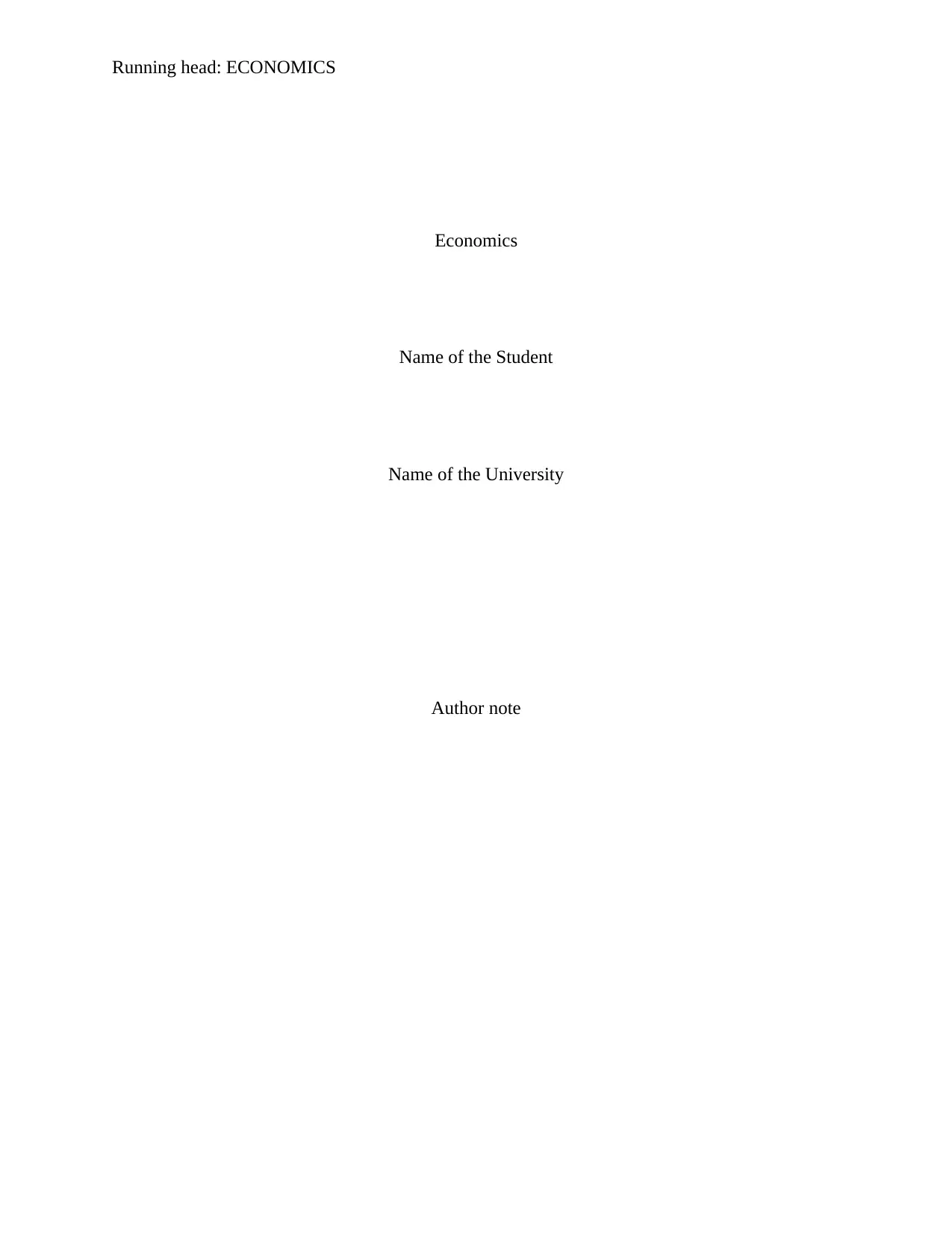
Running head: ECONOMICS
Economics
Name of the Student
Name of the University
Author note
Economics
Name of the Student
Name of the University
Author note
Paraphrase This Document
Need a fresh take? Get an instant paraphrase of this document with our AI Paraphraser
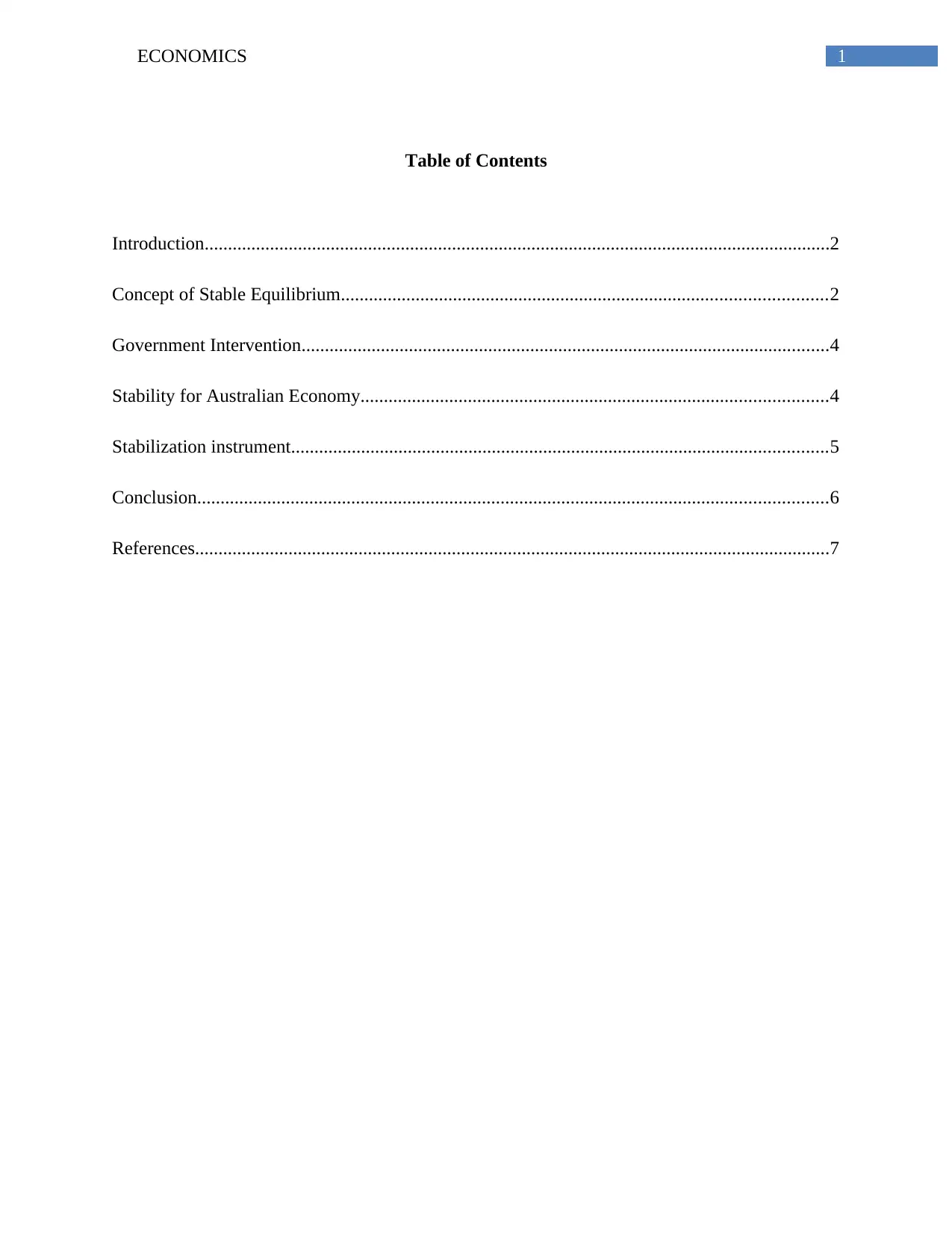
1ECONOMICS
Table of Contents
Introduction......................................................................................................................................2
Concept of Stable Equilibrium........................................................................................................2
Government Intervention.................................................................................................................4
Stability for Australian Economy....................................................................................................4
Stabilization instrument...................................................................................................................5
Conclusion.......................................................................................................................................6
References........................................................................................................................................7
Table of Contents
Introduction......................................................................................................................................2
Concept of Stable Equilibrium........................................................................................................2
Government Intervention.................................................................................................................4
Stability for Australian Economy....................................................................................................4
Stabilization instrument...................................................................................................................5
Conclusion.......................................................................................................................................6
References........................................................................................................................................7
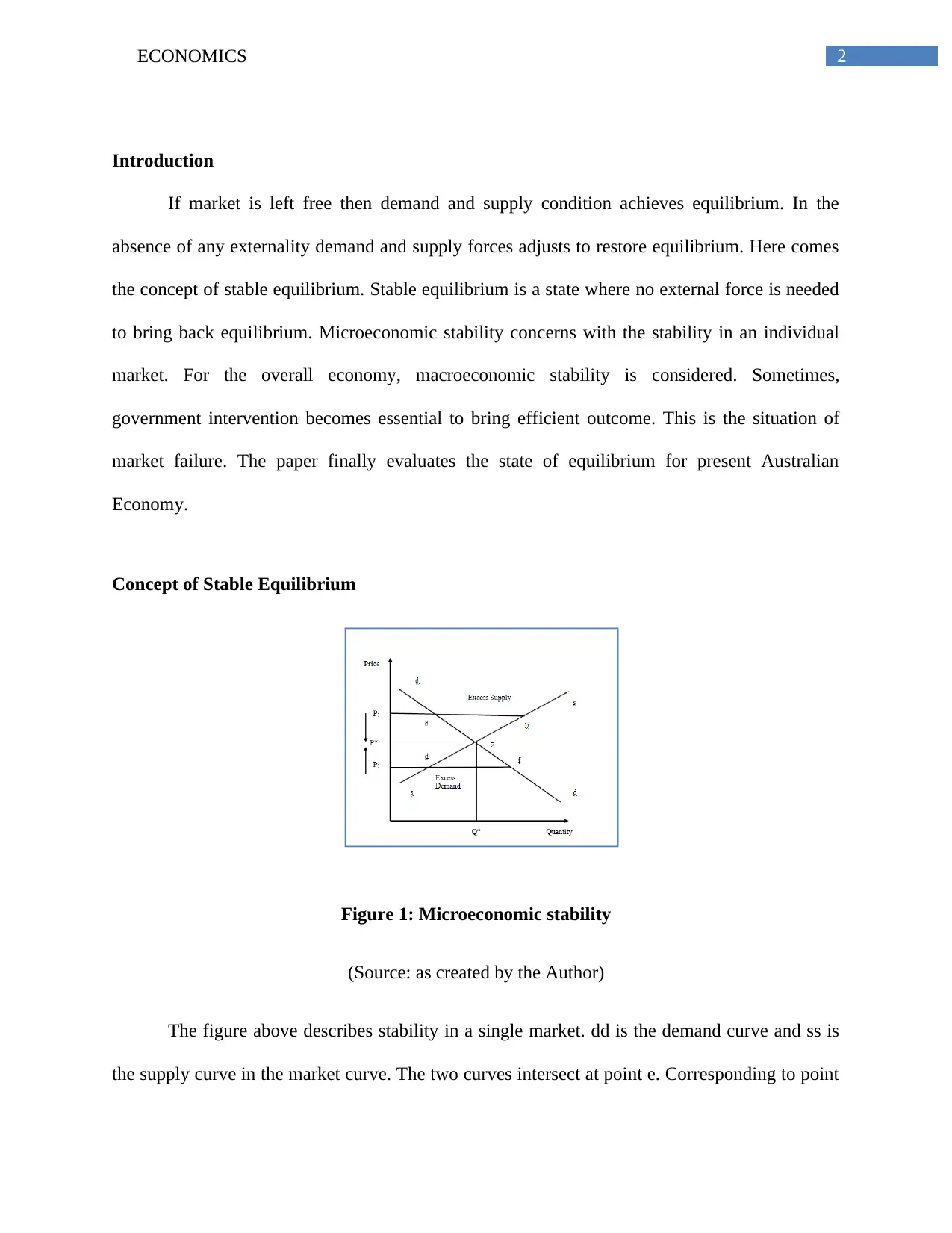
2ECONOMICS
Introduction
If market is left free then demand and supply condition achieves equilibrium. In the
absence of any externality demand and supply forces adjusts to restore equilibrium. Here comes
the concept of stable equilibrium. Stable equilibrium is a state where no external force is needed
to bring back equilibrium. Microeconomic stability concerns with the stability in an individual
market. For the overall economy, macroeconomic stability is considered. Sometimes,
government intervention becomes essential to bring efficient outcome. This is the situation of
market failure. The paper finally evaluates the state of equilibrium for present Australian
Economy.
Concept of Stable Equilibrium
Figure 1: Microeconomic stability
(Source: as created by the Author)
The figure above describes stability in a single market. dd is the demand curve and ss is
the supply curve in the market curve. The two curves intersect at point e. Corresponding to point
Introduction
If market is left free then demand and supply condition achieves equilibrium. In the
absence of any externality demand and supply forces adjusts to restore equilibrium. Here comes
the concept of stable equilibrium. Stable equilibrium is a state where no external force is needed
to bring back equilibrium. Microeconomic stability concerns with the stability in an individual
market. For the overall economy, macroeconomic stability is considered. Sometimes,
government intervention becomes essential to bring efficient outcome. This is the situation of
market failure. The paper finally evaluates the state of equilibrium for present Australian
Economy.
Concept of Stable Equilibrium
Figure 1: Microeconomic stability
(Source: as created by the Author)
The figure above describes stability in a single market. dd is the demand curve and ss is
the supply curve in the market curve. The two curves intersect at point e. Corresponding to point
⊘ This is a preview!⊘
Do you want full access?
Subscribe today to unlock all pages.

Trusted by 1+ million students worldwide
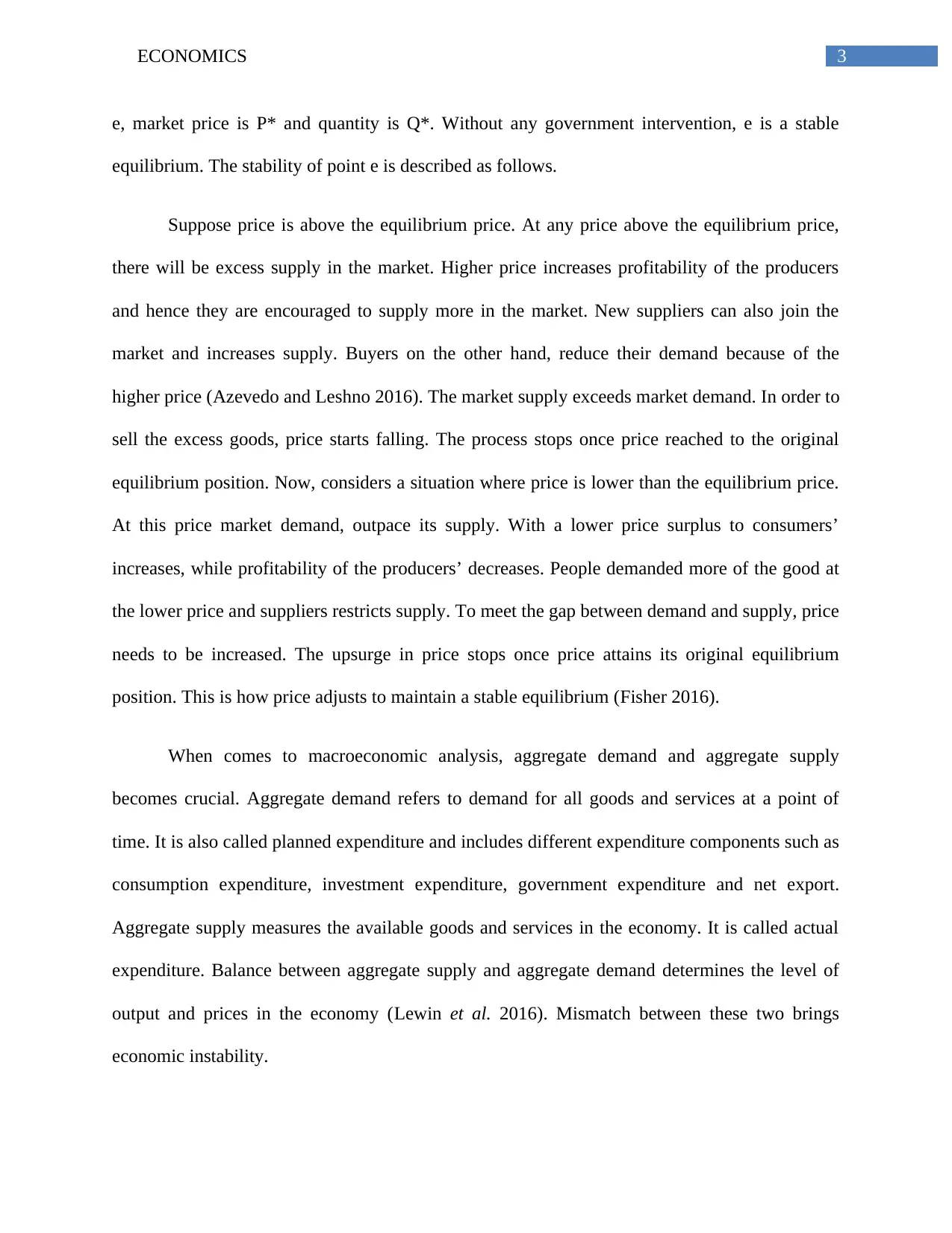
3ECONOMICS
e, market price is P* and quantity is Q*. Without any government intervention, e is a stable
equilibrium. The stability of point e is described as follows.
Suppose price is above the equilibrium price. At any price above the equilibrium price,
there will be excess supply in the market. Higher price increases profitability of the producers
and hence they are encouraged to supply more in the market. New suppliers can also join the
market and increases supply. Buyers on the other hand, reduce their demand because of the
higher price (Azevedo and Leshno 2016). The market supply exceeds market demand. In order to
sell the excess goods, price starts falling. The process stops once price reached to the original
equilibrium position. Now, considers a situation where price is lower than the equilibrium price.
At this price market demand, outpace its supply. With a lower price surplus to consumers’
increases, while profitability of the producers’ decreases. People demanded more of the good at
the lower price and suppliers restricts supply. To meet the gap between demand and supply, price
needs to be increased. The upsurge in price stops once price attains its original equilibrium
position. This is how price adjusts to maintain a stable equilibrium (Fisher 2016).
When comes to macroeconomic analysis, aggregate demand and aggregate supply
becomes crucial. Aggregate demand refers to demand for all goods and services at a point of
time. It is also called planned expenditure and includes different expenditure components such as
consumption expenditure, investment expenditure, government expenditure and net export.
Aggregate supply measures the available goods and services in the economy. It is called actual
expenditure. Balance between aggregate supply and aggregate demand determines the level of
output and prices in the economy (Lewin et al. 2016). Mismatch between these two brings
economic instability.
e, market price is P* and quantity is Q*. Without any government intervention, e is a stable
equilibrium. The stability of point e is described as follows.
Suppose price is above the equilibrium price. At any price above the equilibrium price,
there will be excess supply in the market. Higher price increases profitability of the producers
and hence they are encouraged to supply more in the market. New suppliers can also join the
market and increases supply. Buyers on the other hand, reduce their demand because of the
higher price (Azevedo and Leshno 2016). The market supply exceeds market demand. In order to
sell the excess goods, price starts falling. The process stops once price reached to the original
equilibrium position. Now, considers a situation where price is lower than the equilibrium price.
At this price market demand, outpace its supply. With a lower price surplus to consumers’
increases, while profitability of the producers’ decreases. People demanded more of the good at
the lower price and suppliers restricts supply. To meet the gap between demand and supply, price
needs to be increased. The upsurge in price stops once price attains its original equilibrium
position. This is how price adjusts to maintain a stable equilibrium (Fisher 2016).
When comes to macroeconomic analysis, aggregate demand and aggregate supply
becomes crucial. Aggregate demand refers to demand for all goods and services at a point of
time. It is also called planned expenditure and includes different expenditure components such as
consumption expenditure, investment expenditure, government expenditure and net export.
Aggregate supply measures the available goods and services in the economy. It is called actual
expenditure. Balance between aggregate supply and aggregate demand determines the level of
output and prices in the economy (Lewin et al. 2016). Mismatch between these two brings
economic instability.
Paraphrase This Document
Need a fresh take? Get an instant paraphrase of this document with our AI Paraphraser
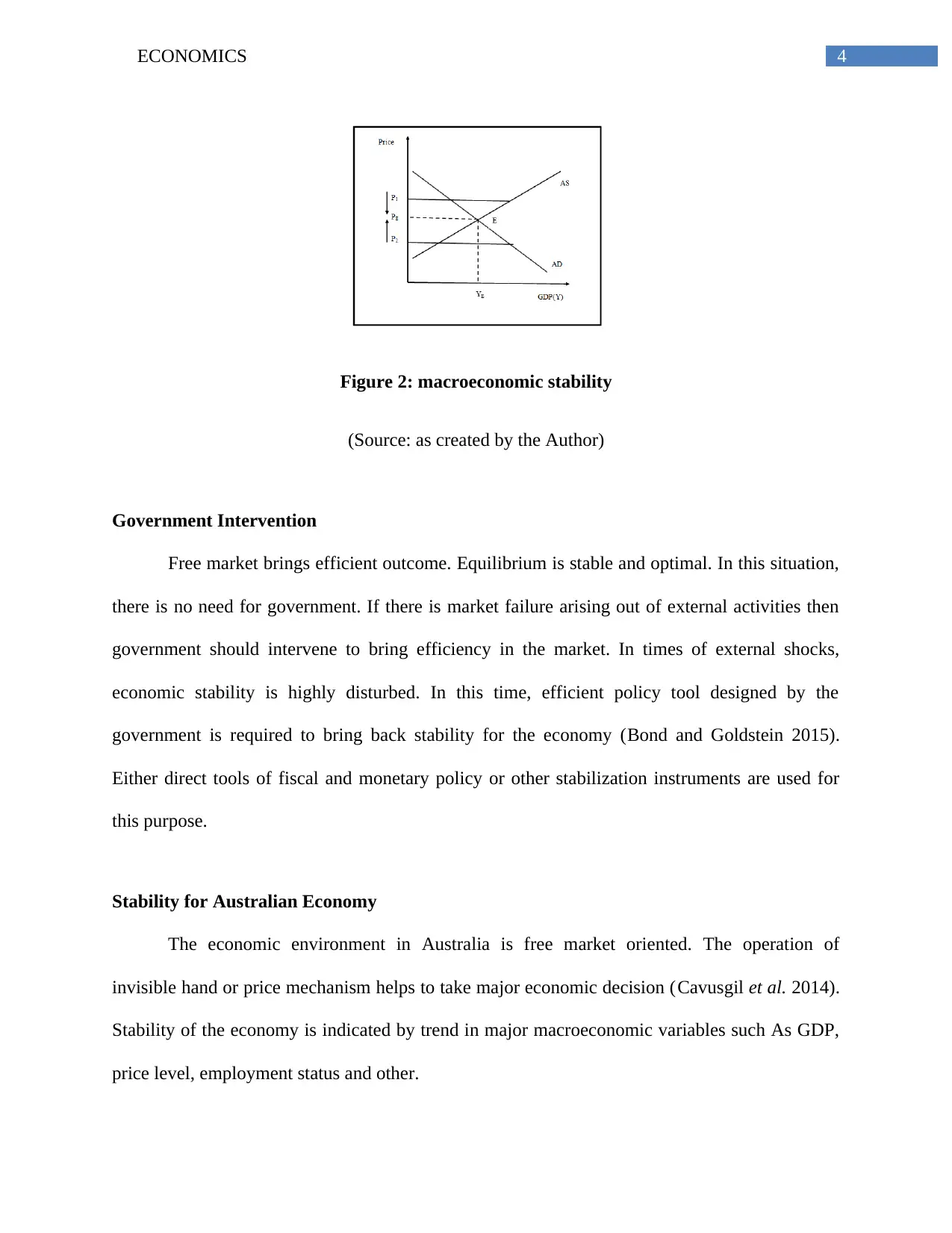
4ECONOMICS
Figure 2: macroeconomic stability
(Source: as created by the Author)
Government Intervention
Free market brings efficient outcome. Equilibrium is stable and optimal. In this situation,
there is no need for government. If there is market failure arising out of external activities then
government should intervene to bring efficiency in the market. In times of external shocks,
economic stability is highly disturbed. In this time, efficient policy tool designed by the
government is required to bring back stability for the economy (Bond and Goldstein 2015).
Either direct tools of fiscal and monetary policy or other stabilization instruments are used for
this purpose.
Stability for Australian Economy
The economic environment in Australia is free market oriented. The operation of
invisible hand or price mechanism helps to take major economic decision (Cavusgil et al. 2014).
Stability of the economy is indicated by trend in major macroeconomic variables such As GDP,
price level, employment status and other.
Figure 2: macroeconomic stability
(Source: as created by the Author)
Government Intervention
Free market brings efficient outcome. Equilibrium is stable and optimal. In this situation,
there is no need for government. If there is market failure arising out of external activities then
government should intervene to bring efficiency in the market. In times of external shocks,
economic stability is highly disturbed. In this time, efficient policy tool designed by the
government is required to bring back stability for the economy (Bond and Goldstein 2015).
Either direct tools of fiscal and monetary policy or other stabilization instruments are used for
this purpose.
Stability for Australian Economy
The economic environment in Australia is free market oriented. The operation of
invisible hand or price mechanism helps to take major economic decision (Cavusgil et al. 2014).
Stability of the economy is indicated by trend in major macroeconomic variables such As GDP,
price level, employment status and other.
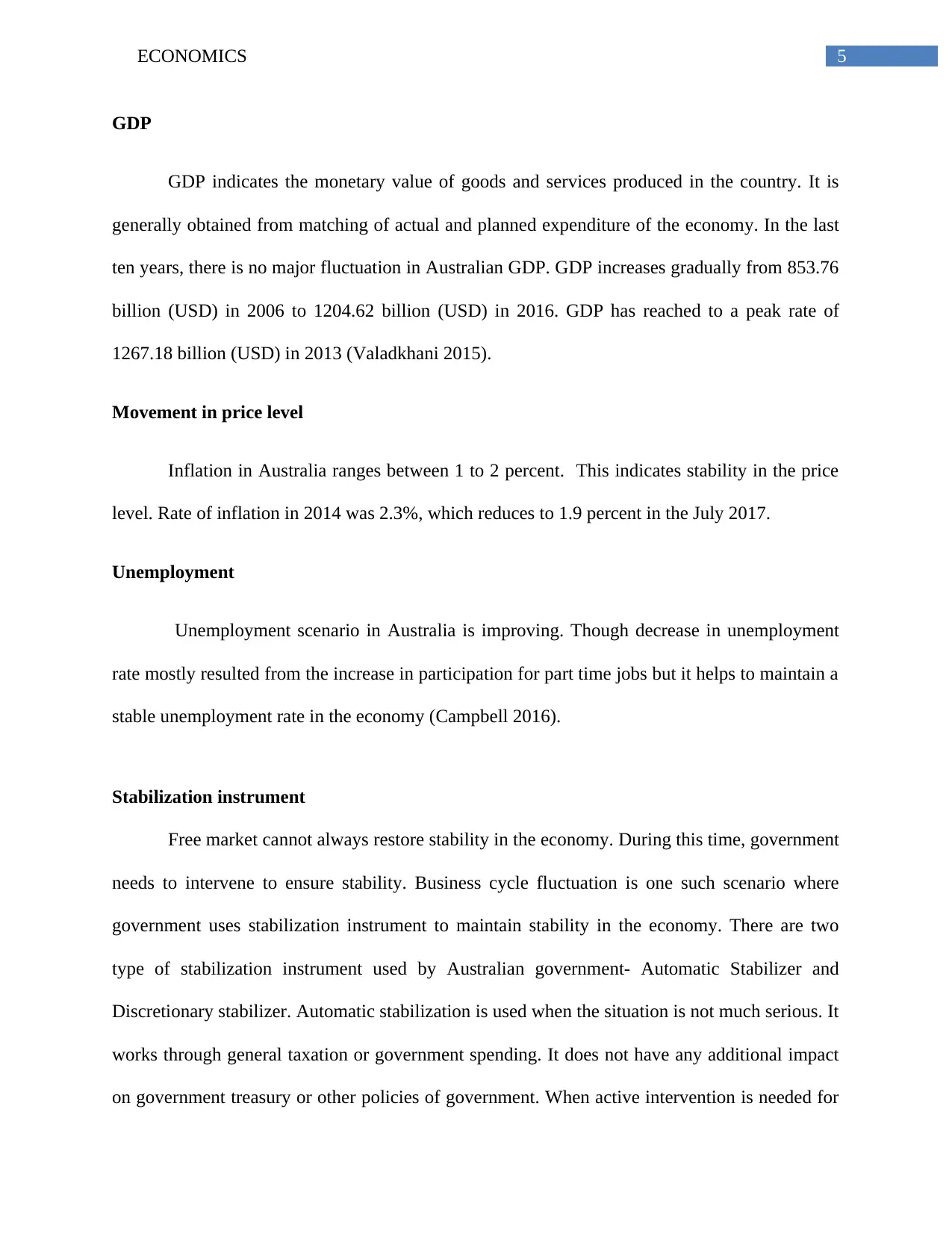
5ECONOMICS
GDP
GDP indicates the monetary value of goods and services produced in the country. It is
generally obtained from matching of actual and planned expenditure of the economy. In the last
ten years, there is no major fluctuation in Australian GDP. GDP increases gradually from 853.76
billion (USD) in 2006 to 1204.62 billion (USD) in 2016. GDP has reached to a peak rate of
1267.18 billion (USD) in 2013 (Valadkhani 2015).
Movement in price level
Inflation in Australia ranges between 1 to 2 percent. This indicates stability in the price
level. Rate of inflation in 2014 was 2.3%, which reduces to 1.9 percent in the July 2017.
Unemployment
Unemployment scenario in Australia is improving. Though decrease in unemployment
rate mostly resulted from the increase in participation for part time jobs but it helps to maintain a
stable unemployment rate in the economy (Campbell 2016).
Stabilization instrument
Free market cannot always restore stability in the economy. During this time, government
needs to intervene to ensure stability. Business cycle fluctuation is one such scenario where
government uses stabilization instrument to maintain stability in the economy. There are two
type of stabilization instrument used by Australian government- Automatic Stabilizer and
Discretionary stabilizer. Automatic stabilization is used when the situation is not much serious. It
works through general taxation or government spending. It does not have any additional impact
on government treasury or other policies of government. When active intervention is needed for
GDP
GDP indicates the monetary value of goods and services produced in the country. It is
generally obtained from matching of actual and planned expenditure of the economy. In the last
ten years, there is no major fluctuation in Australian GDP. GDP increases gradually from 853.76
billion (USD) in 2006 to 1204.62 billion (USD) in 2016. GDP has reached to a peak rate of
1267.18 billion (USD) in 2013 (Valadkhani 2015).
Movement in price level
Inflation in Australia ranges between 1 to 2 percent. This indicates stability in the price
level. Rate of inflation in 2014 was 2.3%, which reduces to 1.9 percent in the July 2017.
Unemployment
Unemployment scenario in Australia is improving. Though decrease in unemployment
rate mostly resulted from the increase in participation for part time jobs but it helps to maintain a
stable unemployment rate in the economy (Campbell 2016).
Stabilization instrument
Free market cannot always restore stability in the economy. During this time, government
needs to intervene to ensure stability. Business cycle fluctuation is one such scenario where
government uses stabilization instrument to maintain stability in the economy. There are two
type of stabilization instrument used by Australian government- Automatic Stabilizer and
Discretionary stabilizer. Automatic stabilization is used when the situation is not much serious. It
works through general taxation or government spending. It does not have any additional impact
on government treasury or other policies of government. When active intervention is needed for
⊘ This is a preview!⊘
Do you want full access?
Subscribe today to unlock all pages.

Trusted by 1+ million students worldwide
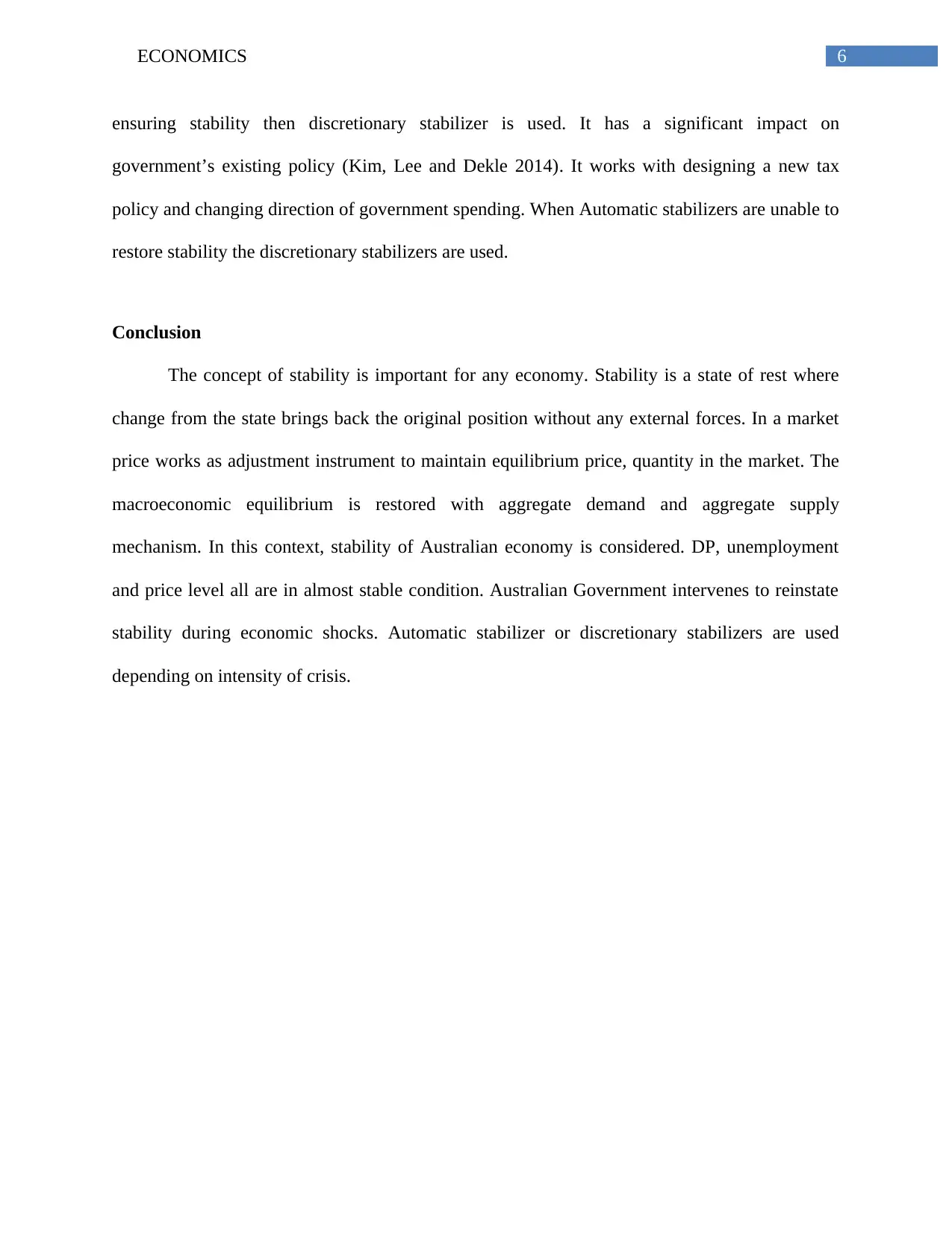
6ECONOMICS
ensuring stability then discretionary stabilizer is used. It has a significant impact on
government’s existing policy (Kim, Lee and Dekle 2014). It works with designing a new tax
policy and changing direction of government spending. When Automatic stabilizers are unable to
restore stability the discretionary stabilizers are used.
Conclusion
The concept of stability is important for any economy. Stability is a state of rest where
change from the state brings back the original position without any external forces. In a market
price works as adjustment instrument to maintain equilibrium price, quantity in the market. The
macroeconomic equilibrium is restored with aggregate demand and aggregate supply
mechanism. In this context, stability of Australian economy is considered. DP, unemployment
and price level all are in almost stable condition. Australian Government intervenes to reinstate
stability during economic shocks. Automatic stabilizer or discretionary stabilizers are used
depending on intensity of crisis.
ensuring stability then discretionary stabilizer is used. It has a significant impact on
government’s existing policy (Kim, Lee and Dekle 2014). It works with designing a new tax
policy and changing direction of government spending. When Automatic stabilizers are unable to
restore stability the discretionary stabilizers are used.
Conclusion
The concept of stability is important for any economy. Stability is a state of rest where
change from the state brings back the original position without any external forces. In a market
price works as adjustment instrument to maintain equilibrium price, quantity in the market. The
macroeconomic equilibrium is restored with aggregate demand and aggregate supply
mechanism. In this context, stability of Australian economy is considered. DP, unemployment
and price level all are in almost stable condition. Australian Government intervenes to reinstate
stability during economic shocks. Automatic stabilizer or discretionary stabilizers are used
depending on intensity of crisis.
Paraphrase This Document
Need a fresh take? Get an instant paraphrase of this document with our AI Paraphraser
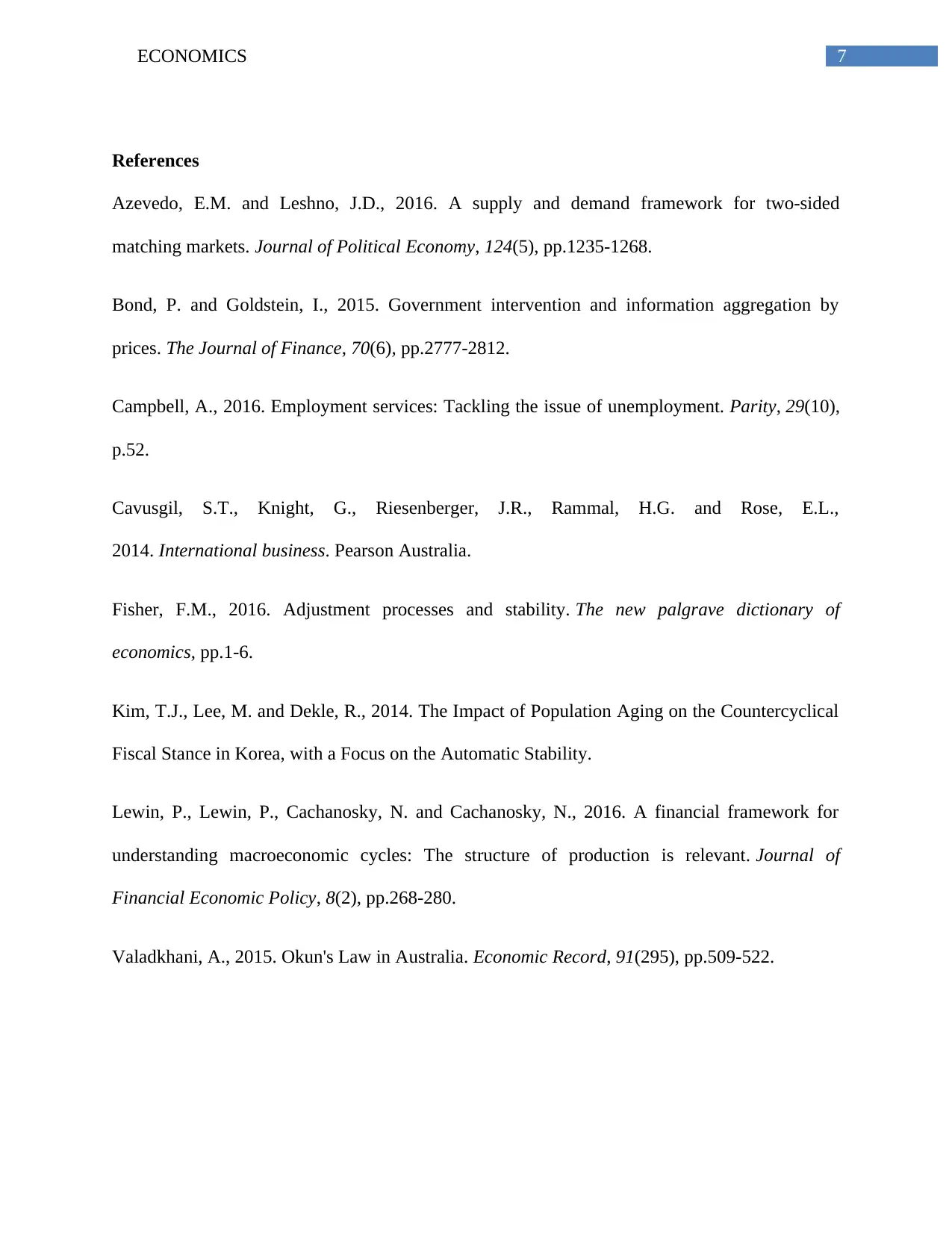
7ECONOMICS
References
Azevedo, E.M. and Leshno, J.D., 2016. A supply and demand framework for two-sided
matching markets. Journal of Political Economy, 124(5), pp.1235-1268.
Bond, P. and Goldstein, I., 2015. Government intervention and information aggregation by
prices. The Journal of Finance, 70(6), pp.2777-2812.
Campbell, A., 2016. Employment services: Tackling the issue of unemployment. Parity, 29(10),
p.52.
Cavusgil, S.T., Knight, G., Riesenberger, J.R., Rammal, H.G. and Rose, E.L.,
2014. International business. Pearson Australia.
Fisher, F.M., 2016. Adjustment processes and stability. The new palgrave dictionary of
economics, pp.1-6.
Kim, T.J., Lee, M. and Dekle, R., 2014. The Impact of Population Aging on the Countercyclical
Fiscal Stance in Korea, with a Focus on the Automatic Stability.
Lewin, P., Lewin, P., Cachanosky, N. and Cachanosky, N., 2016. A financial framework for
understanding macroeconomic cycles: The structure of production is relevant. Journal of
Financial Economic Policy, 8(2), pp.268-280.
Valadkhani, A., 2015. Okun's Law in Australia. Economic Record, 91(295), pp.509-522.
References
Azevedo, E.M. and Leshno, J.D., 2016. A supply and demand framework for two-sided
matching markets. Journal of Political Economy, 124(5), pp.1235-1268.
Bond, P. and Goldstein, I., 2015. Government intervention and information aggregation by
prices. The Journal of Finance, 70(6), pp.2777-2812.
Campbell, A., 2016. Employment services: Tackling the issue of unemployment. Parity, 29(10),
p.52.
Cavusgil, S.T., Knight, G., Riesenberger, J.R., Rammal, H.G. and Rose, E.L.,
2014. International business. Pearson Australia.
Fisher, F.M., 2016. Adjustment processes and stability. The new palgrave dictionary of
economics, pp.1-6.
Kim, T.J., Lee, M. and Dekle, R., 2014. The Impact of Population Aging on the Countercyclical
Fiscal Stance in Korea, with a Focus on the Automatic Stability.
Lewin, P., Lewin, P., Cachanosky, N. and Cachanosky, N., 2016. A financial framework for
understanding macroeconomic cycles: The structure of production is relevant. Journal of
Financial Economic Policy, 8(2), pp.268-280.
Valadkhani, A., 2015. Okun's Law in Australia. Economic Record, 91(295), pp.509-522.
1 out of 8
Related Documents
Your All-in-One AI-Powered Toolkit for Academic Success.
+13062052269
info@desklib.com
Available 24*7 on WhatsApp / Email
![[object Object]](/_next/static/media/star-bottom.7253800d.svg)
Unlock your academic potential
Copyright © 2020–2025 A2Z Services. All Rights Reserved. Developed and managed by ZUCOL.





